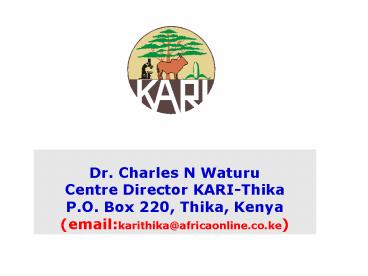Dr' Charles N Waturu - PowerPoint PPT Presentation
1 / 38
Title: Dr' Charles N Waturu
1
Dr. Charles N Waturu Centre Director
KARI-Thika P.O. Box 220, Thika, Kenya
(emailkarithika_at_africaonline.co.ke)
2
Title of Presentation
- The Status of the Bt-cotton Confined Field Trials
in Kenya
3
Bt-cotton Experimental Phases
- Phase I- Baseline Arthropod Survey
- Phase II-Screen-house Evaluation
- Phase III-Confined Field Trial
4
Purpose of Bt-cotton Introduction
- Experiment Bt-cotton with Cry IAc Prot
- Active on Lepidopteran insects
- Aim to establish efficacy of protein
5
Transgenic Bt cotton
- Plants with transgene expressing Bt proteins
toxic to Lep pests - Bt proteins much more persistent and effective
- Bt toxins in plants reduce the need for
insecticides - Bt cotton one of the plants approved for
commercial production
6
Justification of Introduction
- Collapse of cotton production in Kenya
- Pest control take 32 of production costs
- African Bollworm most important cotton pest
- Can cause 100 yield loss if un-checked
- Synthetic pyrethroids for bollworm control
- Othersstainers, whiteflies, aphids and Mites
- IPM best for cotton pests
7
Benefits of Bt-cotton
- Bt-cotton control bollworms
- Bt-cotton indirectly control sucking pests
- Increased activity of natural enemies
- Reduced spraying with pesticides
- Reduce environmental pollution
- No effect on beneficial insects
- Safe to human beings
- Chances of resistance reduced
8
Important Cotton PestsChewing Pests
- African bollworm H. armigera
- Spiny bollwom E. insulana/biplaga
- Pink bollworm P. gossypiella
- Cotton leafworms Spodoptera sp.
9
Important Cotton Pests Bollworm larvae on Square
10
Important Cotton Pests Bollworm on Cotton Boll
11
Important Cotton Pests Bollworm Damage
12
Important Cotton Pests Semi-looper and
Damage (Sporadic)
13
Important Cotton Pests Sucking Pests
- Red Spider Mite Tetranychus spp.
- Jassid Empoasca spp.
14
Important Cotton Pests Sucking Pests
- Aphids A. gossypii
- Whitefly B.tabaci
- Cotton stainers Dysdercus spp
15
Baseline Arthropod Survey
- Phase I
- Pre-introduction baseline Characterization and
quantification of arthropods
16
Objective
- Establish a reference baseline for arthropod
diversity for comparison with studies after
introduction of Bt-cotton
17
Methodology
Sticky and Water traps
Pitfall trap
18
Methodology
- Districts covered Meru, Kitui, Malindi, Kirinyaga
- Trapping methods-direct counts and water, pitfall
and sticky traps - Trapped arthropods recovered every week for 4
weeks. - Arthropods sampling on plants conducted for 4
weeks. - Preserved specimens identified at the NARL
19
Results
- Arthropods recovered in orders Hymenoptera,
Coleoptera, Homoptera, Lepidoptera, Acarina,
Hemiptera and Diptera. - Arthropods in these orders included important
cotton pests and natural enemies. - Reference collection of voucher specimens of
species of various taxa maintained
20
Screen-house Evaluation
- Phase II
- Screen-house Evaluation of NuCotn 35B
- For Impact on African bollworms and Non-
- target Arthropods
21
Objectives
- Verify direct (bitrophic) effect on Tricho spp.
- Verify indirect (tritrophic) effect on Tricho
spp. - Verify effect on A. gossypii
- Verify efficacy on African bollworms
22
Methodology
23
Results
- No direct/indirect effect on Tricho spp.
- No effect on Aphids
- Effective on African bollworms
24
Confined Field Trial (CFT)
- Phase III
- Field Evaluation of Transgenic Bt-Cotton
- DP448B and DP 404BG for Efficacy on
- African Bollworms and its Impact on Non-
- target Species
25
Objectives
- Effect of Bt-cotton on natural enemies
- Risk of intercrossing with the Bt-cotton
- Evaluate economic advantage of Bt-cotton
- Efficacy on African Bollworms
- Impact on other arthropods
26
Methodology
- Test Varieties
- DP 448B-Bt Cotton
- DP 404BG-Bt Cotton
- DP 5415-Isoline
- DP 4049-Isoline
- HART 89M-Local commercial variety
27
Methodology Treatments
- Code Treatment Details
- A DP 448B Untreated
- B DP 448B Treated 6 times for sucking pests
- C DP 404BG Untreated
- D DP 404BG Treated 6 times for sucking pests
- E DP 5415 Untreated
- F DP 5415 Treated 6 times for sucking pests
- G DP 4049 Untreated
- H DP 4049 Treated 6 times for sucking pests
- I HART 89M Untreated
- J HART 89M Treated 6 times for sucking pests
28
Methodology Variety Characteristics
29
MethodologyExperimental design and
layout
- Experimental Design RCBD
- 4 replications
- 10 treatments
- 5 x 5m plot size
- 3m between blocks
- 2m between plots within block
- 70 plants per plot _at_ 30 x 100cm
- 12m buffer of commercial variety
- Blue corner pegs
- Biosafety requirements of site observed
30
Data Collection
- Counts of target and non-target pests
- Counts of damaged squares
- Counts of natural enemies
- Arthropod diversity
- Harvested boll count
- Seed-cotton yield
- Seed sampling for PMG
- Costs and yield data for economic study
31
Data Analysis
- Treatments denoted with codes
- Counts data transformed (SQR of X1)
- 2 way ANOVA
- Student Newman Keuls (SNK) test
- Data presented tabular and graphical
32
Results Bollworm Larvae
Survival
33
Results Damaged Squares
34
Results Semi-looper
Larvae Survival
35
Results Aphid Survival
36
Results Ladybird Beetle
Larvae Survival
37
Bt Cotton Project Output
- Efficacy on African bollworm established
- No effect on egg laying
- Lower square damage for Bt-cotton
- Efficacy on Semi-looper established
- No impact on key natural enemies
- No impact on other arthropods
- PMG established
- Bt-cotton give better returns
38
THANK YOU










![[PDF] READ Free Riffing with Larry Charles: Behind the scenes of ‘mask PowerPoint PPT Presentation](https://s3.amazonaws.com/images.powershow.com/10071700.th0.jpg?_=20240703039)




















